TORONTO (May 28) — The Toronto Raptors and Golden State Warriors will make history in a couple of ways when they meet for the 2019 National Basketball Association title. It is, of course, the first appearance of a Canadian team in the NBA Finals… and the defending champion will close out an arena that has a deep–routed hockey past. Games 3, 4 and 6 will be played at Oracle Arena, home of the Warriors, and — once upon a time — home–ice to the fabled and faulty California Seals of the National Hockey League.
Hockey, in fact, was played exclusively at what was then the Oakland Coliseum–Arena from 1967–68 to 1971–72 when the Warriors moved across the Bay from the Cow Palace in San Francisco. Starting next season, the dynastic NBA team will again call San Francisco home, as it opens the Chase Center in the city’s Mission Bay district. Oakland’s hockey tenant arrived as part of the NHL’s Great Expansion in 1967, when the league doubled to 12 teams. The California Seals were joined by the Los Angeles Kings, Minnesota North Stars, Philadelphia Flyers, Pittsburgh Penguins and St. Louis Blues. The San Francisco Seals of the Western Hockey League had played at the Cow Palace through the 60’s, but moved into the Oakland Coliseum–Arena when it opened on Nov. 9, 1966. In anticipation of the NHL, the name changed to the California Seals.
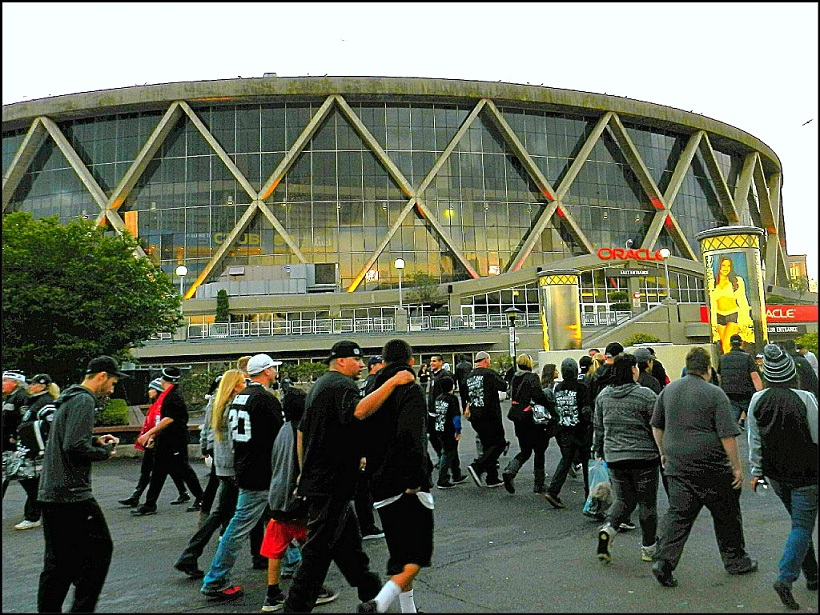
I SNAPPED THIS PHOTO (ABOVE) OF ORACLE ARENA WHILE LEAVING THE ADJACENT OAKLAND COLISEUM ON DEC. 21, 2014. ME AND MY SON, SHANE, HAD JUST WATCHED THE OAKLAND RAIDERS DEFEAT THE BUFFALO BILLS, 26–24. THE PHOTO, BELOW, WAS TAKEN IN NOVEMBER 1966, WHEN THE BUILDING OPENED AS THE OAKLAND COLISEUM–ARENA.

The NHL’s initial foray into northern–California is romanticized upon reflection far–more than it was accepted by fans in the Bay Area (the second foray, beginning in 1991 with the San Jose Sharks, has been a resounding success). For as long as possible, the staid and snooty NHL resisted the expanding trend of other North American leagues, choosing to remain a six–team loop that reached no–farther west than Chicago. Competition arrived for two of the sports in the mid–60’s with the American Basketball and Football Leagues — both featuring teams from coast–to–coast in the United States — and going head–to–head with the NBA and NFL. Major League Baseball had been in California since 1958 when the New York Giants and Brooklyn Dodgers re–located to San Francisco and Los Angeles. Only the NHL — with its tight, little circuit of Boston, Chicago, Detroit, Montreal, New York and Toronto — refused to migrate beyond the Central time zone.
But, a factor the league could no longer ignore dramatically altered its stance: Television.
Though NHL games had been shown sporadically on network TV in the U.S. — beginning in 1956–57 when CBS aired a Saturday matinee — it still lacked the comprehensive, multi–year arrangements of baseball, basketball and football. In its ongoing research, the league finally understood that no–such contract would materialize until it spanned the Pacific time zone… and became truly national. The afternoon of March 11, 1965 is therefore among the seminal moments in hockey history. On that day, the six NHL owners announced an unprecedented scheme — 100 percent expansion. The addition of six new clubs for the 1967–68 season, including, without question, franchises in Los Angeles and the San Francisco Bay Area.
Thus were born the California Seals. Rather than playing at the decrepit Cow Palace, the new NHL (old WHL) club remained at the glass–walled structure across the Bay. To its everlasting peril. During the Seals’ entire nine–year existence, hockey fans in San Francisco were loathe to cross the bridge into Oakland — poor cousin of the Bay Area (think, for a moment, about people in Toronto needing to travel to Hamilton to watch the “Ontario” Maple Leafs). The club, therefore, changed its name to “Oakland” Seals before December of the first season, looking to focus on fans in the east Bay. Neither did that work particularly well. Having run out of Bays in which to draw ticket buyers, the green–clad NHL outfit staggered through nine mostly–dreadful seasons, making the playoffs only twice (losing to Los Angeles in 1969 and Pittsburgh in 1970).
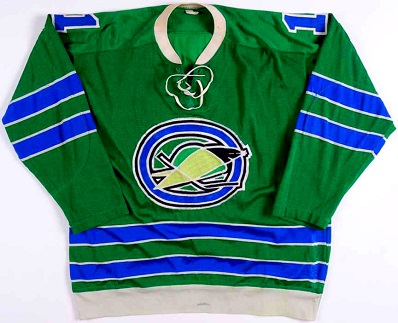

OAKLAND SEALS HOME–GREEN AND ROAD–WHITE JERSEYS — 1967–68 AND 1968–69.
Nonetheless, the building known today as Oracle Arena hosted the greatest names in hockey history: Gordie Howe, Bobby Hull, Stan Mikita, Bobby Orr, Phil Esposito, Dave Keon, Frank Mahovlich, Tim Horton, Jean Beliveau and — yes — even Wayne Gretzky, whose first pre–season appearance with the Los Angeles Kings (October 1988 vs. Detroit) took place in Oakland. The greatest coaches in NHL history stood behind the visiting bench in Oakland: Scotty Bowman, Toe Blake, Punch Imlach, Al Arbour among them. Even Donald S. Cherry, with Boston, during the Seals’ final two years. The Leafs were the defending Stanley Cup champions and on their way to missing the playoffs in the initial year of expansion when they made their first visit to Oakland. It was Johnny Bower’s 43rd birthday on Nov. 8, 1967 and the Seals presented him a cake in a pre–game ceremony at center ice. After blowing out the candles, Bower blew away the Seals. With two goals from Jim Pappin and Murray Oliver; singles by Ron Ellis and Allan Stanley, the Maple Leafs cruised to a 6–1 triumph (photo of Ellis and Bill Hicke and story–lead, by George Gross, below, in the old Toronto Telegram).
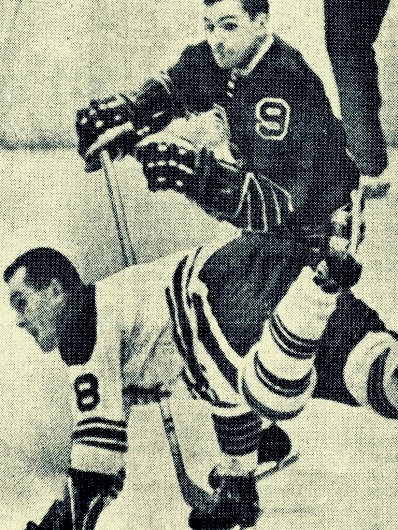
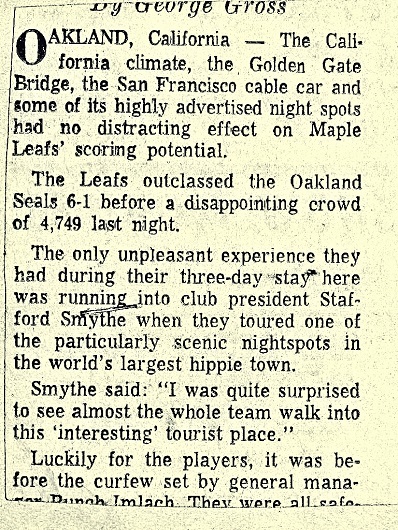
In the summer of 1970, the Seals were purchased by Charles O. Finley, owner of the Oakland A’s. Finley’s first act was to change the team colors from green and blue to gold and green, thus matching his baseball team. He twice renamed the club before the start of the 1970–71 season — first the Bay Area Seals, then the California Golden Seals. Unlike his baseball team, which would triumph in three consecutive World Series (1972–73–74), the Seals were a laughingstock under Finley, never winning more than 21 games (or losing less than 39) in a season. In its final two years, the ill–fated hockey club was run, first, by the NHL; then, by San Francisco hotel magnate Mel Swig. Colors were again changed to “Pacific” blue and “California” gold.
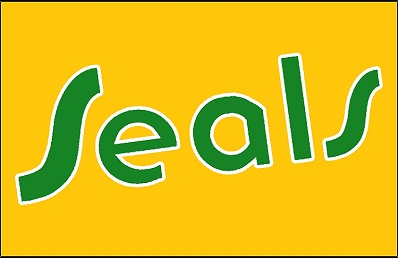

CALIFORNIA GOLDEN SEALS LOGOS. LEFT: 1970-71 TO 1973–74. RIGHT: 1974–75 AND 1975–76.

THE TORONTO MAPLE LEAFS AND CALIFORNIA GOLDEN SEALS ARGUE AT THE OAKLAND COLISEUM–ARENA ON FEB. 19, 1975 DURING A 3–3 TIE. TORONTO PLAYERS (LEFT–TO–RIGHT) ARE DARRYL SITTLER, BORJE SALMING, DAVE DUNN AND DAVE (TIGER) WILLIAMS. GILLES MELOCHE IS THE CALIFORNIA GOALIE. AL MacADAM WEARS NO. 25 FOR THE SEALS. VETERAN DEFENSEMAN JIM NEILSON (EX–NEW YORK RANGER) IS OVER DUNN’S RIGHT SHOULDER.
The final NHL game at the Oakland Coliseum–Arena was played on Apr. 4, 1976 — the Seals defeating the Los Angeles Kings, 5–2 (the Leafs final road match against the Seals was a wild 7–7 tie on Mar. 7, 1976). Hockey in Oakland was officially dead. For the 1976–77 season, the club moved to an enormous structure in the tiny village of Richfield, Ohio and became the Cleveland Barons. Neither attendance nor results on the ice changed, as the 20,000–seat Richfield Coliseum (located in a farmer’s field between Cleveland and Akron) rarely drew crowds exceeding 5,000. Though the former Seals had another flashy logo (below), the team gradually expired and merged rosters with the Minnesota North Stars for the 1978–79 season.
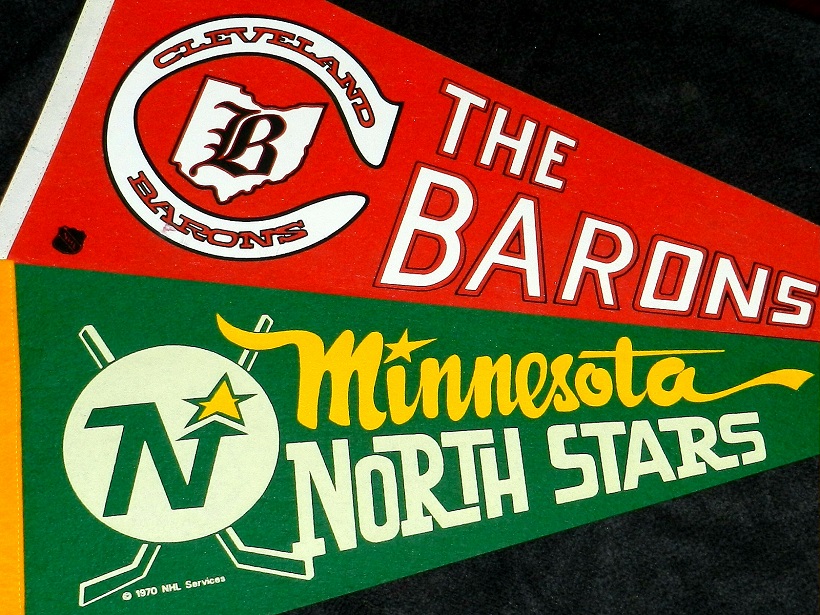
And, so, the Golden State Warriors will appear for the last time at Oracle Arena either Friday, June 7 (in Game 4 of the Finals) or Thursday, June 13 (Game 6, if necessary). The future of the 53–year–old structure was recently the subject of a story in the San Francisco Chronicle: “Although the Warriors will be gone, Oracle will continue to host concerts, events and other sporting events, like high school and college games. That’s the short-term plan. Long term, there are more questions. The stadium is tied up with the Oakland Coliseum, home (for now) of the Oakland A’s. The 135-acre Coliseum site has had a number of proposals over the past few years as the A’s planned and re-planned their exit from the area. In most of the proposals, the Coliseum is torn down and the area is redeveloped for residential and commercial use.”
The Oakland Raiders — co–tenants with the A’s in the stadium across from Oracle Arena — are bound for Las Vegas as early as the 2020 NFL season, pending completion of a 65,000–seat domed facility in neighboring Paradise, Nevada. The Raiders played at the Coliseum from 1966 to 1981 before moving to Los Angeles for 14 years. The club returned to Oakland for the 1995 football season.

POSTCARD FROM 1967 — THE EARLY DAYS OF THE OAKLAND ALAMEDA–COUNTY SPORTS COMPLEX.

WHILE CLIMBING OUT OF SAN FRANCISCO INTERNATIONAL AIRPORT TO TORONTO ON DEC. 25, 2014, WE FLEW EAST OVER THE BAY… AND DIRECTLY OVER–TOP THE ALAMEDA–COUNTY SPORTS COMPLEX (LOCATED OFF THE NIMITZ FREEWAY AT HEGENBERGER RD). ORACLE ARENA (RED TOP) AND THE ADJACENT OAKLAND COLISEUM ARE AT BOTTOM–LEFT IN THE PHOTO, ABOVE. I SNAPPED A CLOSER SHOT (BOTTOM–RIGHT). THE WARRIORS HAVE PLAYED AT ORACLE ARENA SINCE 1971.
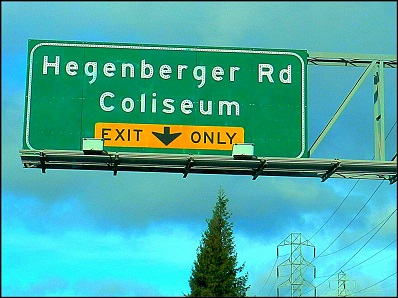
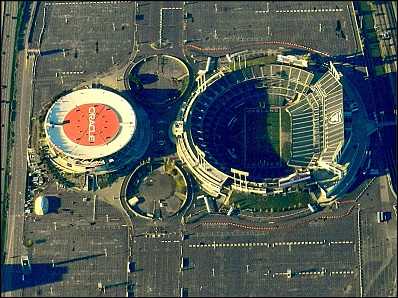

THE CHASE CENTER (LOWER–LEFT) IS RISING ON THE WATER IN THE MISSION BAY DISTRICT IN EAST SAN FRANCISCO, SEVERAL BLOCKS SOUTH OF ORACLE PARK (CIRCLED IN RED), HOME OF THE BASEBALL GIANTS. THE SAN FRANCISCO–OAKLAND BAY BRIDGE IS IN UPPER–RIGHT OF PHOTO.
EMAIL: HOWARDLBERGER@GMAIL.COM



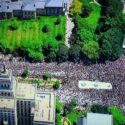
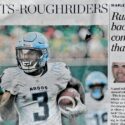



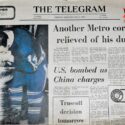
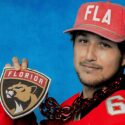





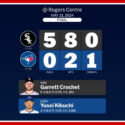

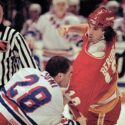
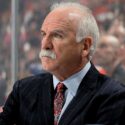

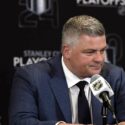
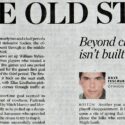
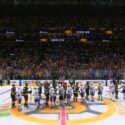
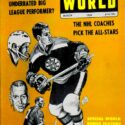





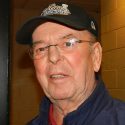

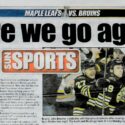




I have often made reference to my ‘toughest’ game – Philadelphia Flyers at Oakland Seals – Flyers beat up on Mike Christie in the bench emptying brawl days of old! Fought until Clarke said to let him off the ice for medical attention. Jimmy Neilson, I remember him as only significant Seal to come to his aid. Was told next night Flyers at Canucks that seatbelts were installed on Flyers Bench so they could not get off…ya right!